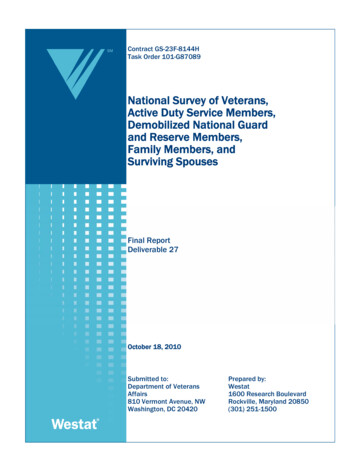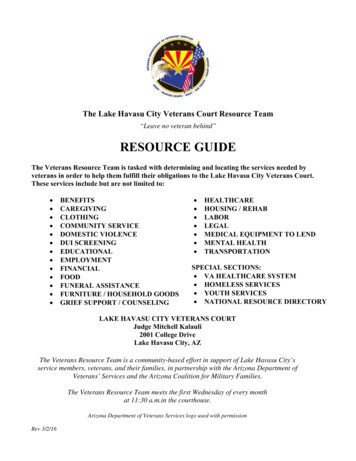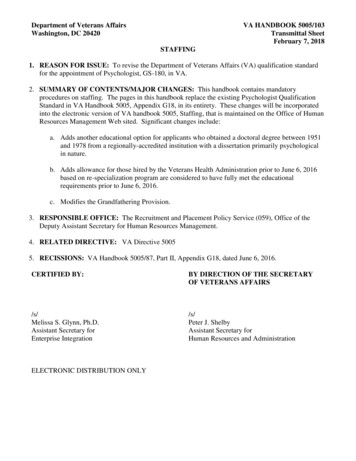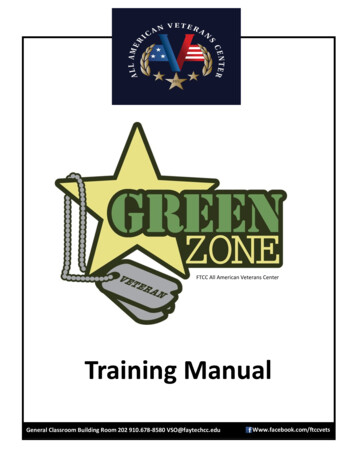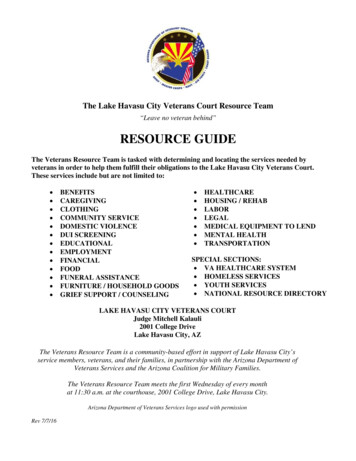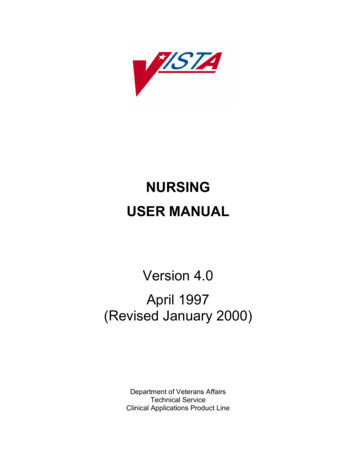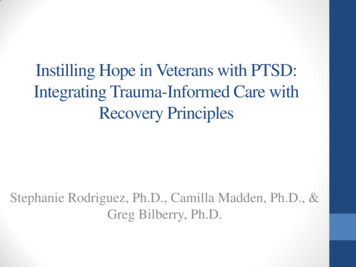
Transcription
Instilling Hope in Veterans with PTSD:Integrating Trauma-Informed Care withRecovery PrinciplesStephanie Rodriguez, Ph.D., Camilla Madden, Ph.D., &Greg Bilberry, Ph.D.
Disclosure to AudienceNo one involved in the planning or presentation of this activity has any relevant financial relationshipswith a commercial interest to discloseThe following are North Star Behavioral Health’s Content Controllers:Cheri Scott, Stone Soup Group - PresenterDr. Andy Mayo, CEODr. Ruth Dukoff, System Medical DirectorLori Hoffman, QIRM DirectorDenise Gleason, CME CoordinatorEvelyn Alsup, Education DirectorMedical Staff:Dr. Phillip NeubergerDr. Manuel RodriguezDr. Elizabeth BaisiDr. David HjellenDr. Judith BautistaDr. Jill AbramEducation Committee:Sabrina Ben, HRDCarla MacGregor, AdministratorRon Meier, PRTC AdministratorMelanie Nelson, AdministratorSarah Skeel, PRTC AdministratorBusiness Development Department:Elke Villegas, Director of Business DevelopmentBecky Bitzer, Clinical Community LiaisonSarah Twaddle, Clinical Community LiaisonWayne Jackson, Clinical Community Liaison
Common Themes in PTSD Trauma often violates a person’s need for: Safety Trust Power/Control Intimacy Esteem(Rosenbloom, Williams, & Watkins, 2010)
PTSD and Veterans Current 4.8% & Lifetime 8% Combat (Lifetime) 24-35% OIF & OEF 11-20% Gulf War 12% Vietnam War (Current) 15% & (Lifetime) 30% Military Sexual Trauma (Lifetime) 10-15% Current for Women (29.4%) and Men (24.5%) Some studies suggest Veterans of color may havehigher rates of PTSD(Loo, C., 2014; National Academic Press, 2014; National Center for PTSD, 2015; Wisco, Marx, Wolf, Miller,Southwick, & Pietrzak, 2014)
Common Responses to Trauma Immediate and Delayed Reactions Emotional Physical Cognitive Behavioral Existential(SAMHSA, 2014)
Co-Occurring Disorders Individuals with PTSD often have at leastone additional mental health disorder Major Depression Anxiety Disorders Substance Use Disorders Eating Disorders Personality Disorders Bidirectional relationship between traumaand mental illness(SAMHSA, 2014; Ursano, R., Benedek, D., & Engel, C., 2012)
Trauma-Informed Care Realizes the widespread impact of trauma andunderstands potential paths for recovery; Recognizes the signs and symptoms of trauma inclients, families, staff, and others involved with thesystem; Responds by fully integrating knowledge abouttrauma into policies, procedures, and practices; and Seeks to actively resist re-traumatization.(SAMHSA, 2014)
Trauma-Informed Care and RecoveryRecovery ModelTrauma-Informed Care Cultural, historical, and genderissues Safety Trustworthiness andtransparency Peer support Collaboration and mutuality Empowerment, voice andchoice(SAMHSA, 2014) n-linearStrengths basedPeer supportRespectResponsibilityHope(APA, 2012)
Cultural Considerations(SAMHSA, 2014)
Safety Promote safety from trauma symptoms Safety in environment Monitor and facilitate stability Prevent recurrence of trauma Provide psychoeducation/normalizesymptoms Interpersonal/agency approach(SAMHSA, 2014)
Safety Trauma-informed interventions Teach grounding skills Provide structure/rituals to promote routine andsense of familiarity Help identify safe vs unsafe behaviors Develop a safety plan Identify and manage trauma-related triggers Teach balance and acceptance(SAMHSA, 2014)
Trustworthiness and Transparency Be consistent and dependable Develop clear boundaries Provide honest feedback Use authentic and compassionate communication Be consistent and forthright Provide clear message of availability andaccessibility throughout treatment Encourage an on-going dialog(SAMHSA, 2014)
Collaboration and Mutuality Foster Client Engagement Motivational Interviewing & MotivationalEnhancement Techniques Develop a supportive, collaborative, andempathetic relationship Provide Veterans with control, choice, andautonomy in their treatment decisions(SAMHSA, 2014)
Collaboration and Mutuality Couple and Family Therapies Family members can help with engagement in care Family can be a source of support REACH Cognitive-Behavior Conjoint Therapy Veteran Parenting Toolkit Community Resources MakeTheConnection.net NAMI Family to Family Vet Center(National Academic Press, 2014)
Empowerment, Voice and Choice “Nothing about me without me.” Collaborate on treatment goals Include in planning and decision making Engage, inspire, coach, teach and support Strengths based approach Posttraumatic growth Educate on Types of therapies available CBT, CPT, PE, EMDR, STAIR, Seeking Safety Pharmacological Options(SAMSHA, 2014)
Empowerment, Voice and Choice Assess for strengths Resilience Scale Connor Davidson Resilience Scale Dispositional Resilience Scale The Wellness Questionnaire Dr. Seligman’s Positive Psychology VIA Survey of Signature Strengths (2015) www.Authentichappiness.sas.upenn.edu(SAMHSA, 2014)
Peer Support Enhancement of treatment by providingopportunity for: Mentorship/Role Modeling/Peer-to-Peer Support Hope Interpersonal Connectivity Normalization of Experiences Connection to Community Resources Consumer Driven Feedback and Collaboration forImplementing Programming(SAMHSA, 2014)
Special Considerations Combat Veterans Battlemind and transition to civilian life Moral Injury Influences on occupational and socialfunctioning Traumatic Brain Injury CogSmart: Cognitive Symptom Management andRehabilitation Therapy for Traumatic Brain Injury(Maguen & Litz, 2012; National Academic Press, 2014; Twamley, Noonan, Savla, Schiehser, & Jak,2009)
Special Considerations Military Sexual Trauma 1/5 Women Veterans enrolled in VA care screen positive for MST 14% of Veterans enrolled in VA care are women 1.1% report of MST among men There are about equal numbers of men and women who experienceMST National screening data of outpatient Veterans in 2008 48,106 women and 43,693 menViolation of trustHealth correlatesVet Center and MST coordinatorHonor requests for same-sex or opposite-sex therapist(Hyun, Pavao, & Kimerling, 2009; National Academic Press, 2014)
The Trauma-Informed Provider Awareness of symptoms associated withtrauma Anticipates and responds to potential practicesthat may be perceived or experienced as retraumatizing View symptoms as adaptive response that mayno longer be helpful Personal awareness of how verbal/non-verbalmessages influence Veteran Responding versus Reacting(SAMHSA, 2014)
The Trauma-Informed Provider Universally screens and assesses for trauma Stressful Life Experiences Scale (SLE)Combat Exposure ScaleIntimate Partner Violence Screening ToolTrauma History Questionnaire (THQ)Clinician Administered PTSD Scale (CAPS)ACEs Score Calculator http://acestudy.org/ace score Provide on-going assessment andmonitoring PTSD Checklist (PCL)(SAMHSA, 2014)
The Trauma-Informed Provider Treatment planning considerations Identify recovery from trauma as a primary goal Veteran-Centered Collaborate and use Veteran’s words Connect with personal values Consider treatment plan a tool for empowerment Build connection beyond the provider to thecommunity and natural support networks Address domains of family, occupational, physical, &spiritual functioning(SAMHSA, 2014)
The Trauma-Informed Provider Treatment planning considerations (cont.) Strengths Needs Abilities Preferences (SNAP) Specific Measurable Achievable Realistic Timely(SMART) Involve Peer Support Stages of Change Model by Dr. Prochaska Wellness Wheel Identify Barriers and Resources Focus on strengths(SAMHSA, 2014)
The Trauma-Informed Provider Examples of Recovery Oriented Interventions Use person-first language Always introduce to services, activities, interventions,and familiarize to organizational practices Provide a rationale Identify cross-cultural considerations and integrate intotreatment Collaborative documentation Obtain consumer feedback to inform practices(SAMHSA, 2014)
The Trauma-Informed Provider Fosters trauma-resistant skills Inform how trauma impacts lives Make connection between relationship of experiencing trauma tocurrent presentation/symptoms Teach self-care strategiesTeach coping strategiesConnect to supportive networksFoster sense of competence, hope, and mastery Practices self-care strategies, has awareness ofsigns of secondary traumatization, and takessteps to prevent compassion fatigue Provider Resilience app (National Center for Telehealth &Technology, 2014)(SAMHSA, 2014)
Always Promote HopeRecovery is Possible
Readings on Combat RelatedPsychological Issues Invisible Wounds of War: Psychological and Cognitive Injuries, TheirConsequences, and Services to Assist Recovery (Tanielian & Jaycox,2008) On Killing (Grossman, 1995) Haunted by Combat (Paulson & Krippner, 2007) Treating Young Veterans: Promoting Resilience Through Practice andAdvocacy (Kelly, Howe-Barksdale, & Gitelson, 2011)
ReferencesAmerican Psychological Association (2012). Recovery principles. Retrieved inciples.aspxHyun, J., Pavao, J., & Kimerling, R. (2009). Military sexual trauma. PTSD Research Quarterly, 20(2).Retrieved from: quarterly/v20n2.pdfLoo, C. (2014). PTSD among ethnic minority Veterans. Retrieved cultural/ptsd-minority-vets.aspMaguen, S., & Litz, B. (2012). Moral injury in Veterans of war. PTSD Research Quarterly, 23(1). Retrievedfrom: quarterly/v23n1.pdfNational Academic Press (2014). Treatment for posttraumatic stress disorder in military andVeteran populations: Final assessment. Washington, D.C.: National Academic Press.National Center for Telehealth & Technology (2014). Provider Resilience (Version 1.5) [Mobileapplication software].National Center for PTSD (2015). How common is PTSD? Retrieved from: on-is-ptsd.aspxRosenbloom, D., Williams, M., & Watkins, B. (2010). Life after trauma-2nd edition: A workbook forhealing. New York, NY: The Guilford Press.
ReferencesSeligman, M. (2015). VIA survey of signature strengths. Retrieved from:www.Authentichappiness.sas.upenn.eduSubstance Abuse and Mental Health Service Administration (2014). Trauma-informed care in behavioralhealth services. Treatment Improvement Protocol (TIP) Series 57. HHS Publication No. (SMA)13-4801. Rockville, MD: Substance Abuse and Mental Health Services Administration, 2014.Tsai, J., Sippel, L.M, Mota, N., Southwick, S.M.& Pietrzak, R.H. (2015). Longitudinal course ofposttraumatic growth and US military Veterans: Results from the National Health andResilience in Veterans Study. Depression and Anxiety, doi. 10.1002/da.22371Twamley, E., Noonan, S., Savla, G., & Jak, A. (2009). Cognitive Symptom Management andRehabilitation Therapy (CogSMART) for Traumatic Brain Injury. University of California,San Diego VA Healthcare System.United States Department of Veterans Affairs (2015). Make the connection: Shared experiences andsupport for Veterans. Retrieved from: www.MakeTheConnection.netUrsano, R., Benedek, D., & Engel, C. (2012). Trauma-informed care for primary care: Thelessons of war. Annals of Internal Medicine, 157(12), 905-907.Wisco, B., Marx, B., Wolf, E., Miller, M., Southwick, S., Pietrzak, R. (2014). Posttraumatic stressdisorder in the US Veteran population: Results from the National Health and Resiliencein Veterans Study. Journal of Clinical Psychiatry, 75(12), 1338-46.
Photo Credit Photos retrieved h?q diversity hands%2c safety&view detailv2&id ndex 30&ccid E9h%2B5YoQ&simid 607997800110231022&thid JN.dqwcqivCrJ%2FD1BebuKNB1g&mode overlay&first tyles/dose 505/public/ptsd-brain.jpg?itok regonstate.edu/bewell/sites/default/files/wellness wheel 1.jpg
North Star BHS – CME Activity Course Evaluation FormDate: June 30, 2015Agency/Location: North Star Behavioral Health, AnchorageTopic: Instilling Hope in Veterans with PTSD: Integrating Trauma-Informed Care with Recovery PrinciplesPresenter(s): Stephanie Rodriguez, Ph.D., Camilla Madden, Ph.D. & Greg Bilberry, Ph.D. - Clinical Psychologists, Alaska VA Healthcare SystemAt the conclusion of this activity, participants should be able to:Not at AllSlightlyModeratelyMostlyIdentify the 10 principles of recovery-oriented care.Evaluate and treat Veterans with PTSD-evidenced by being able toidentify at least three trauma-informed considerations when developinga recovery oriented treatment plan.Implement treatment conceptualization and interventions by being ableto identify three recovery-oriented interventions when providing traumainformed care to Veterans with PTSD.Was the presentation commercially biased in any manner?Yes []No []Based on this activity, what will you do differently in your practice?Topics of Interest for future Seminars:Printed Name of CME participant:Physician Yes [ ] No [ ]Signature of CME participant:Agency/Organization:Email:Are you on our email distribution list? Yes [ ] No [ ]If not – do you wish to be added for future CME events? Yes [ ] No [ ]Completely
Special Considerations Military Sexual Trauma 1/5 Women Veterans enrolled in VA care screen positive for MST 14% of Veterans enrolled in VA care are women
